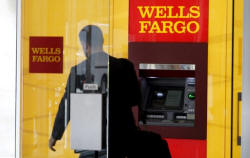|
Wells Fargo trims auto loans
as market cools, risk overhaul kicks in
 Send a link to a friend
Send a link to a friend
 [July 12, 2017]
By Dan Freed [July 12, 2017]
By Dan Freed
NEW YORK (Reuters) - Wells Fargo & Co is
scaling back and remolding its auto lending business in response to
growing stress in the market, as well as a bank-wide push for more
centralized risk controls.
Wells, which was the No. 2 U.S. provider of auto loans less than a year
ago, has already cut quarterly originations by nearly 30 percent over
the nine months leading into March 31, according to a May 11 company
presentation. It has also begun consolidating the collections operation
in a move that people familiar with the business say could eliminate
hundreds of jobs, after a new head of auto finance took the reins in
April.
Wells Fargo joins other lenders in reducing exposure to the rapidly
cooling U.S. auto market. Bankers, auto industry executives, analysts
and regulators have been warning since 2014 that the auto loan market
could overheat after being fueled for years by low interest rates and
easy financing terms.
Chasing growth, some lenders, including Wells Fargo, began to embrace
borrowers with shaky credit. In late 2015, however, auto default rates
began creeping above other types of consumer debt, according to data
compiled by Cox Automotive, prompting some lenders to tighten standards
and edge away from the market.

Wells Fargo began curtailing its auto exposure beginning last year. It
cut the share of subprime loans in the auto portfolio to over 8 percent
in the first quarter from over 11 percent a year earlier, according to a
company presentation.
Analysts expect to see higher delinquency and default rates when Wells
Fargo reports results on Friday.
"The general view, which they've been pretty clear about, is that loan
growth will be negative for next two to three quarters," said Brian
Foran, an analyst at Autonomous Research. He expects the auto pullback
to shave roughly one percentage point off Wells Fargo's net interest
income growth over time.
The bank's executives have acknowledged that tightening of standards
comes at a price.
"Wells Fargo is willing to give up volume and share in order to protect
its balance sheet from credit risk," Franklin Codel, the bank's head of
consumer lending, told the bank's investor day in May.
At the same event, Chief Executive Officer Tim Sloan singled out auto
loans as the business with the biggest potential for a "negative credit
event."
A Wells Fargo spokeswoman declined to comment for this story beyond what
executives have already said about auto lending.
As Wells Fargo's auto loan originations have dropped, it has slipped to
No. 7 from No. 2 among top U.S. auto lenders, according to Experian
Automotive.
The bank also began a revamp of its auto business early this year as
part of a broad overhaul following a sales scandal that has roiled the
third-largest U.S. bank by assets.


[to top of second column] |

A man walks by a bank machine at the Wells Fargo & Co. bank in
downtown Denver, Colorado, U.S. April 13, 2016. REUTERS/Rick Wilking/File
Photo

In April, Laura Schupbach took over management of the auto business,
months after her predecessor, Dawn Martin Harp, announced plans to
leave. Schupbach is a 22-year Wells Fargo veteran who most recently ran
its insurance business after various roles in finance and expenses,
according to her corporate biography.
Weeks later, the bank began the process of moving collections staff from
57 locations across the country to three central hubs in Raleigh, North
Carolina, Irving, Texas and Chandler, Arizona, according to an internal
memo viewed by Reuters.
People with knowledge of the business say hundreds of positions will
likely be eliminated. A bank spokeswoman declined to say how many jobs
might be lost, and would not authorize an interview with Schupbach.
Martin Harp could not be reached.
LESS INDEPENDENCE
The auto lending shake-up, some details of which were first reported by
Auto Finance News, is the latest indication that Wells Fargo's top
management is seeking greater control over businesses that traditionally
operated with much independence.
In interviews, three people who have worked inside the auto lending
operation raised questions about what impact the abandoning of the "run
it like you own it" philosophy will have in the long term.
In recent years auto lending delivered nearly twice as much in revenue
per dollar of expenses as the overall bank, according to people familiar
with the numbers.
They attributed the performance to tight cost controls and the
operational independence that was once a source of pride for Wells
Fargo. But that business model has come under scrutiny after revelations
that thousands of branch employees created as many as 2.1 million
accounts to hit aggressive sales targets.

Following an internal investigation, Wells Fargo's directors released a
report in April recommending tighter and more centralized risk
management. Since then, Wells has begun moving 5,200 risk employees from
business units to one "corporate risk" division.
Although the changes could make businesses less nimble, tighter controls
were inevitable, said Marty Mosby, analyst at Vining Sparks.
"It was hard for them to give up that last piece of who they really
were," he said. "That's what made them more profitable than the other
bank."
(Reporting by Dan Freed; Editing by Lauren Tara LaCapra and Tomasz
Janowski)
[© 2017 Thomson Reuters. All rights
reserved.] Copyright 2017 Reuters. All rights reserved. This material may not be published,
broadcast, rewritten or redistributed. |